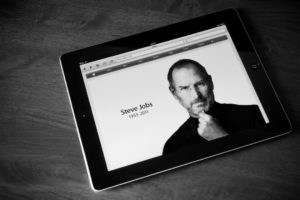09.11.19
Think Different: 5 Marketing Lessons from Apple
Karl R. LaPan, President & CEO, The NIIC

I confess I have a love-hate relationship with my Apple products. Sometimes it totally botches what I write, sometimes my iPhone dials a number when I hang up too fast after a call, sometimes lately it skips letters when I write a text, but Apple just announced the release of its iPhone 11. While its innovations have clearly disrupted the market over a long period of time (iPhone, iPad, streaming services, iWatches and a plethora of other products and services), over the years, I think the company’s success lies more in its marketing efforts than in the technology itself. I have to admit I am often jealous of what Samsung has done, but for interoperability purposes I keep my iPhone, iMac and iPad, not ditching them for the better battery life, the 5G readiness, and the wireless charging options that makes Samsung the success it is!
Think about it for a moment. Almost everything Apple releases succeeds and the media responds accordingly. Moreover, from a financial standpoint, the company reached a record high of 59.53 billion U.S. dollars in its 2018 fiscal year, almost a tenfold increase from its net income ten years ago. They are clearly one of the Big 4 tech stocks – GAFA (Google, Apple, Facebook and Amazon). The world should all ditch Facebook and our lives would be better.
All of this stems from the fact that the company has found a way to marry design with utility in a way that reaches consumers. It’s more than a transaction—Apple has cultivated a tightknit community of loyal brand ambassadors. How do they do it? It starts with the right marketing mix. Here are a few lessons you can take away from Apple’s infiltration into the mainstream.
1. Rethink the need for advertising
Apple doesn’t mess around with costly pay-per-click campaigns or billboards. Instead, they rely on product placement and media buzz. When you find a way to leverage both, the brand speaks for itself.
2. Keep your unique value proposition front and center.
Apple does not compete on price (however, one could question their new pricing strategy with the fledgling iPhone sales). You’ll almost certainly pay more – sometimes a lot more – for an Apple product than another one on the market. How is this sustainable? While other companies focus on a single standout feature in their marketing, Apple sells the entire solution bundle (product, apps, streaming services), and their customer base keeps coming back for more.
3. Simplicity sells.
Apple embraces the mantra that simplicity is the ultimate sophistication. Their products are synonymous with sleek and minimal design. They also have short and memorable names. Think of the “App Store.” Why over-complicate things? Tech can learn a lot from this strategy of approachable simplicity.
4. Elevate customer experience.
The “Apple experience” is robust in that it involves many steps — comparing different product versions, trying out products in the retail store, actually buying the item, receiving it, unboxing and setting it up. The company has been intentional in crafting and refining each one of these elements. They all are supposed to speak to the customer’s sensibilities in some way. In other words, the anticipation and excitement around the product (their packaging, unveiling, keynotes around product launches) become synonymous with the brand, which further drives sales. However, Apple could learn a lot from the incredible and easy customer responsiveness of Amazon. They make it so easy to be satisfied. Apple doesn’t. I have found them difficult and disappointing when you experience service failure almost to the point that you, the customer, is blamed as the problem unless you bought AppleCare+. It is difficult to stay on top with lots of bottom feeders sniping at you. Apple needs to practice WWSJD thinking – What would Steve Jobs do?
5. Build a community
It’s no accident that Apple has created such an enthusiastic fan base. Have you heard someone rave about their PC lately? Not likely. It’s like a cool kid’s club everyone wants to join—the brand personality is fresh, fun, friendly, and above all things, different.
Look no further than the “Think Different” ad campaign? This is an excellent example of how Apple showed customers believe that the brand understands them and is like them.
Bottom line: Apple has cracked the code when it comes to moving consumer electronics. However, the idea here isn’t to mimic Apple. Instead, look to the company (and others) to find creative ways to do the same in your business, while embracing the power of a consistent marketing mix. What do you do in your business to be unique and to have raving fans?

